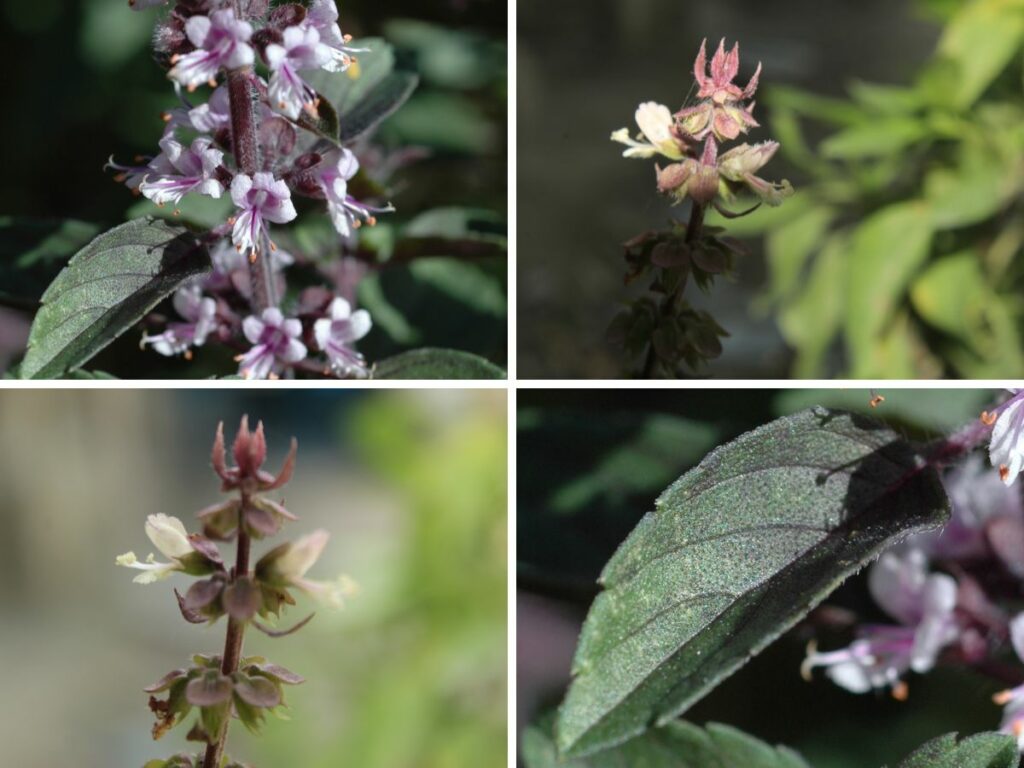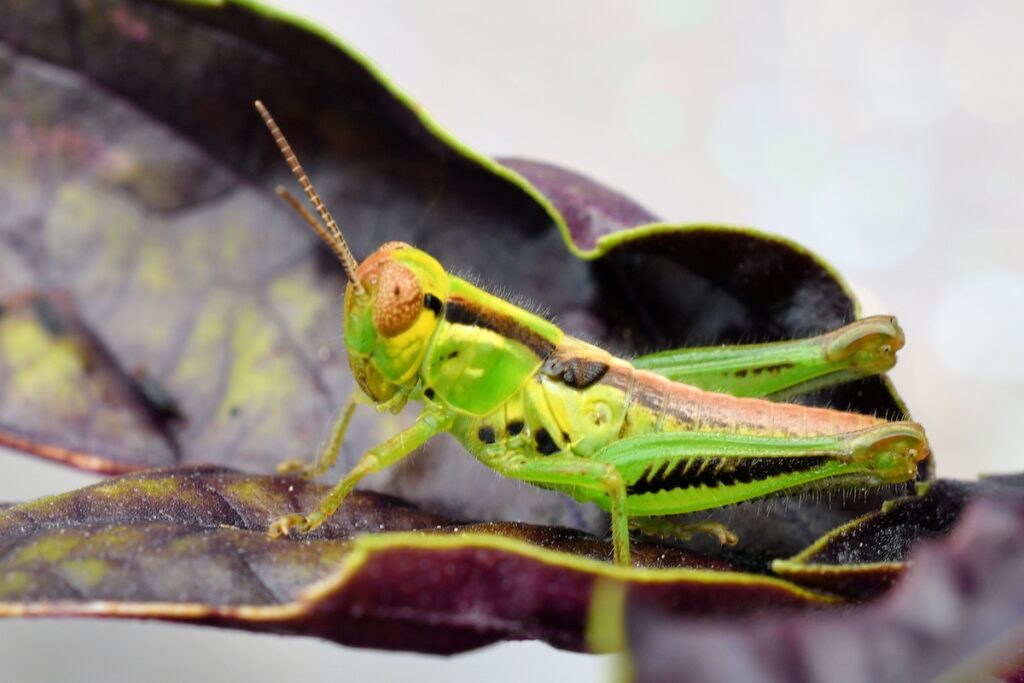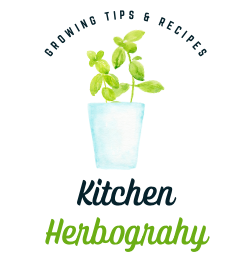As an Amazon Associate I earn from qualifying purchases. This website also participates in other affiliate programs and may earn commissions if you shop through the links used on this website.
(This article was originally published on August 3, 2022 and was last updated on August 3, 2022)
If you are looking for an interesting basil to grow, which can be used as an ornamental and wildlife-friendly plant as well as a culinary herb, then African Blue basil is worth considering. African Blue Basil is a great choice for a bee-friendly garden, looks wonderful in your beds or border, and can be used as a culinary herb, too.
Though this type of basil is suited to warm and tropical climates, it can also be a good choice for many temperate climate areas, too.
As long as you place it in the right place, care for it correctly, and pay attention to its needs, African Blue Basil can grow well in temperate zones.

What is African Blue Basil?
African blue basil is a hybrid plant in the lamiaceae family made by crossing East African camphor basil and a varietal of purple sweet basil called Dark Opal Basil. Its Latin name is Ocimum kilimandscharicum × basilicum ‘Dark Opal’.
African blue basil plants exude a strong camphor scent. This characteristic is inherited from the Ocimum kilimandscharicum – camphor basil – used to breed this plant. While camphor basil has a concentration of 61% camphor, in African blue basil, the concentration is just 22%, but still quite fragrant.
Some find the camphor odor and taste too strong to use this herb in the kitchen. But all parts of the flower, stem, and leaves of an African blue basil plant are edible, and there are plenty of ways that African blue basil can be used for culinary dishes.
Whether you use this plant in the kitchen or not, there are a range of reasons why you might want to grow this type of basil at home.
For one thing, this short-lived perennial can cope with cold temperatures (though not with being frozen), which can extend the growing season in the right climate. In places where it gets cold at night, but a frost isn’t experienced, the plant will be able to grow year round outside, withstanding the coldest months outdoors. In colder climates, it can be grown as an annual, or kept for several years and taken under glass in winter.
And African blue basil flowers are absolutely stunning. A bit taller than most basils, African blue basil plants grow to a height of around 75cm (29.5″), with spires of stunning purple and lavender flowers which are produced on purple stems in summer.
The leaves themselves are a purple green.

Like other basils, African blue basil can also be a useful companion plant and draws in pollinators while in bloom, as well as potentially aiding in pest control in an organic garden.
How to Grow African Blue Basil
African blue basil is a relatively easy herb to grow. However, it is important to make sure that you grow it in the right location, and are aware of its growing needs and how to meet them.
Read on for some basic information to help you cultivate this attractive plant successfully.
Where to Grow African Blue Basil
The most important thing to remember when growing African blue basil is that it needs a site in full sun, with well-drained soil. African blue basil is relatively adaptable when it comes to soil type and pH, but it cannot cope with too much moisture or a waterlogged growing medium, especially in cooler areas.
Like other types of basil, this type of basil can be grown in the ground where the soil is suitable, in a raised bed – either alongside your fruit and vegetable crops in a kitchen garden, or a dedicated herb garden area – or in containers with good quality potting mix.
If you plan to grow this type of basil in a container, remember that the container should be just a little larger than the previous pot, and should be sturdy enough not to tip or blow over when growing these somewhat taller basil plants, which have long stems. Place the container somewhere it will get enough direct sunlight.
Sowing African Blue Basil?
One important thing to note about this type of hybrid basil is that it is sterile. This means that it does not produce seeds. Rather than being grown from seed, African blue basil can only be grown from cuttings.
Cuttings are non-flowering stems cut from the plant in early summer and set in pots or other small containers to form new roots. Using a rooting hormone will increase the chances of the cuttings rooting successfully. Keep the cuttings watered, and within a week or two, new roots should be forming.
Planting African Blue Basil
Once the cuttings are well rooted (if you are propagating plants yourself), or once you have purchased a pot-grown African blue basil plant, you can pot them up into their own individual containers. Or you can plant them out into beds or borders in your garden.
To provide optimal growing conditions, make sure you plant in fertile soil or growing medium. Remember that it must be well-drained.
Once planted, it is a good idea to mulch around the base of the plants with an organic mulch of homemade compost or well-rotted manure. A mulch will help make sure that this plant has the nutrients it needs, and can also aid with moisture retention and weed suppression.
Caring For African Blue Basil
Make sure that you water well during establishment. But make sure that excess water, whether growing in the ground or raised beds or containers, can drain away freely.
If you are growing in the ground, or larger raised beds, watering weekly, to provide an inch or so of water per week, should be sufficient. Remember that container-grown plants will typically need to be watered more frequently.
In fertile soil or growing medium, an organic mulch should be sufficient to fertilize these plants. However, if the growth seems lackluster or when growing in containers, it may be beneficial to feed this type of basil with a nitrogen-rich liquid plant feed (such as a compost tea) through the summer.
The easiest way to make sure you can grow African blue basil over multiple years is to take cuttings each year. However, you can also grow it as a perennial over winter in frost-free locations. If needed, move your plant under cover during the coldest months.
Harvesting African Blue Basil
As with other basil plants, pruning and harvesting African Blue basil are one and the same. As you harvest the upper portions of the plant, this will keep it in check and looking neat and tidy.
This plant can be cut back hard, and it will show strong regrowth in summer. After a heavy harvest/ prune, the plant will typically regrow to its former flowering stage in just a few months.
However, remember that these plants are very beautiful when in flower. Leaving your plants to flower rather than harvesting a lot before flowering (as with other basils), is a great ideas. The purple buds and flowers won’t just look good to you – they can also bring bees and other beneficial insects into your garden.
Try to harvest early in the day, on the day you intend to use them, for the best flavor.
How To Use African Blue Basil
The strong camphor smell, as mentioned above, can be off-putting to some when it comes to using this plant as a culinary herb.
But African blue basil can taste great. The strong taste and odor mean that this herb is best used in moderation in recipes.
It makes a tasty pesto. And can also be used as a pot herb in soups and stews, as well as eaten fresh in green salads or Caprese salads, and used in cocktails, such as this Blue Basil Whiskey Smash.
The flowers as well as the leaves can be used as well, and make a pretty garnish.
African blue basil also has medicinal properties and is used in herbal remedies and teas.
Where to Buy African Blue Basil
Remember, this plant is sterile so you will have to buy plants rather than seeds. Here are some links to purchase African blue basil in the US:
- https://whitwamorganics.com/products/basil-african-blue?variant=8271237873709
- https://www.lazyoxfarm.com/product/basil-plant-african-blue-organic/
- https://www.herbalhaven.com/products/basil-african-blue
If you can’t find it at the links above, talk to a local nursery owner for suggestions, or look at online classifies (Craigslist, Facebook marketplace) in your area, or local gardening groups.
Remember, once you purchase a plant, you can easily take cuttings to propagate your own plants and obtain more for your garden.
Elizabeth is a garden designer, consultancy and writer passionate about growing herbs and other edibles in a sustainable way. She works on her own 1/3 acre garden, growing basil alongside her tomatoes in her polytunnel, and indoors alongside a range of other herbs and crops. She loves inspiring others to get growing and enjoying a home grown diet, wherever they live in the world.

